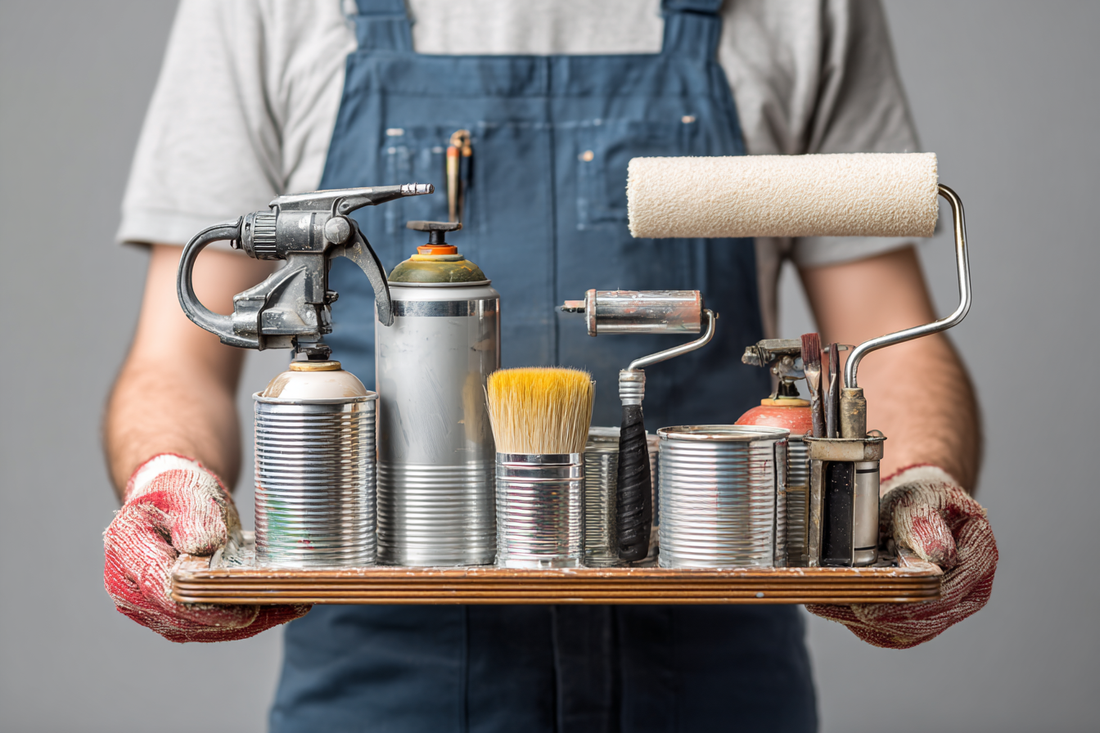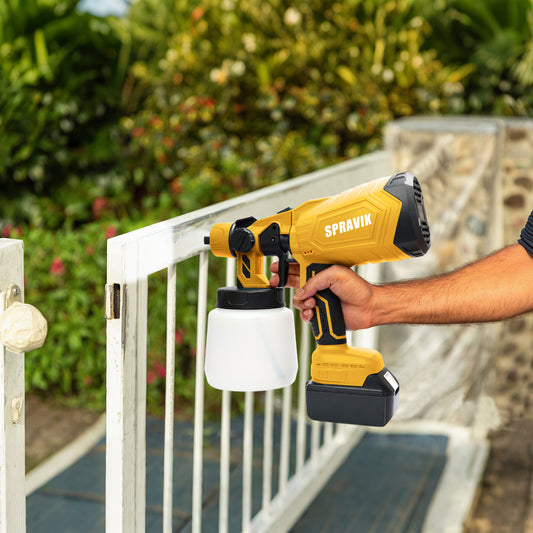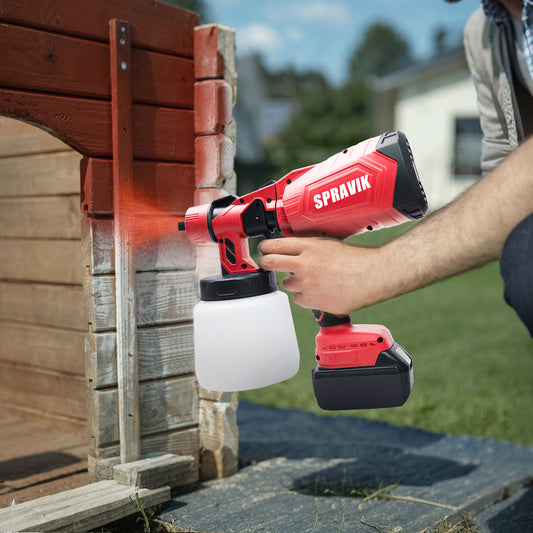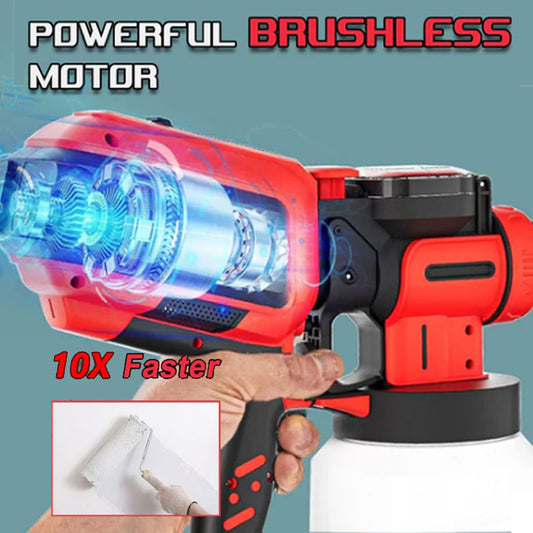
Best Way to Paint Large Surfaces Fast – Sprayer vs Roller vs Brush
Spravik AdminWhen it comes to painting large surfaces—whether it's an interior wall, exterior siding, a fence, or even a ceiling—the choice of tools matters. The right painting method not only determines the finish quality but can also dramatically reduce your project time. Traditionally, brushes and rollers have been the go-to options for homeowners and professionals alike. But in recent years, best paint sprayers have emerged as a powerful alternative, especially with the availability of affordable, easy-to-use models like the HVLP (High Volume Low Pressure) sprayers from Spravik.

This comprehensive guide explores the advantages and disadvantages of sprayers, rollers, and brushes when it comes to painting large areas. Whether you're repainting an entire room or refreshing your home’s exterior, understanding each method will help you choose the most efficient path to professional-grade results.
Let’s start by discussing why speed and efficiency matter so much in large surface painting. Large-scale painting projects can be exhausting and time-consuming if you rely on the wrong tools. The effort involved in loading and reloading paint, reaching high or wide areas, managing drying times, and ensuring even coverage can add hours—or days—to your project. The goal is to work smarter, not harder, and that begins with selecting the right tool for the job.
A paint sprayer is often considered the fastest method for large surface areas. Spravik’s HVLP sprayers are designed to atomize paint into a fine mist, which is then evenly deposited onto the surface. The result? Smooth, consistent finishes in a fraction of the time. Sprayers can cover a large wall or ceiling in minutes—what might take a roller half an hour or more. For exterior siding or fences, sprayers allow you to reach cracks, grooves, and textures that brushes and rollers can’t access effectively.

The major benefit of sprayers is speed and coverage. They offer an even coat without brush marks or roller texture, making them ideal for smooth surfaces or finishes that require a clean look. They’re also excellent for surfaces with intricate textures, grooves, or raised details—think brick, stucco, beadboard, or wooden fencing.
However, sprayers do come with a few caveats. They require more preparation time: masking off trim, windows, doors, and floors is essential to avoid overspray. Cleaning the sprayer components afterward can also take longer compared to cleaning a roller or brush. Sprayers use more paint than other methods due to atomization loss. That said, for large areas, the efficiency gained in actual application time far outweighs the added prep or cleanup.
Rollers are the most commonly used tools for DIY painting projects, especially indoors. They’re relatively fast, easy to control, and don’t require extensive masking. A roller is ideal for large flat walls and ceilings, providing decent speed with minimal mess. Foam or microfiber rollers deliver smooth finishes, while textured rollers can add decorative effects.
The advantages of rollers include affordability, accessibility, and ease of use. They’re beginner-friendly and offer a good balance between speed and control. Rollers don’t require as much masking as sprayers, and you can quickly swap out roller covers for different surfaces.

On the downside, rollers require frequent reloading and may leave lap marks or roller texture if not used properly. They also struggle with corners, edges, or textured surfaces unless used in combination with brushes. While rollers are a good compromise for medium-sized areas, they can become tiring and inefficient for very large projects.
Brushes are the slowest method of the three but offer the most control. They’re perfect for cutting in edges, painting trim, or working on small sections that require precision. When working with rough or detailed surfaces like furniture, molding, or intricate fencing, a brush may be your best tool.
The pros of using brushes include precision, low cost, and minimal equipment. They’re great for touch-ups or small-scale jobs and don’t create overspray. Brushes are also useful for applying specialty paints, stains, or finishes where precision is more important than speed.
However, brushes are not ideal for large surface areas. They take the most time, may leave brush strokes, and can cause fatigue during prolonged use. Using a brush to paint an entire room or fence would be labor-intensive and inefficient.
So how do you decide which tool is best? It depends on your priorities:
If your main goal is speed and you’re painting a large, open surface (like a wall, siding, or fence), go with a paint sprayer.
If you want a balance of speed and control and are painting mostly flat, interior walls or ceilings, a roller might be your best bet.
If you're doing detailed work, cutting in edges, or working in tight spaces, you'll still need a brush—even when using sprayers or rollers.
Another factor to consider is finish quality. Paint sprayers typically offer the smoothest, most consistent coat—ideal for high-end or professional applications. Rollers can create subtle texture, which may be desirable in some rooms. Brushes are best for areas where you need absolute control, like window trim, door edges, or artistic projects.
It’s also worth noting that many professionals use a combination approach. They use a sprayer for the bulk of the surface, then finish with a roller or brush for detail work. This hybrid method gives you the best of all worlds: fast coverage, clean edges, and precise finishing.

When using a sprayer, prep is crucial. Cover floors, windows, fixtures, and furniture with drop cloths or painter’s plastic. Mask trim, electrical outlets, and any area you don’t want to spray. Practice on cardboard before starting to adjust your spray pattern. Spravik sprayers allow you to fine-tune airflow and paint volume, which helps reduce overspray and optimize finish quality.
If using a roller, start by cutting in edges with a brush. Use a high-quality roller frame and extension pole for ceilings and tall walls. Roll in a “W” or “M” pattern, then fill in the gaps without lifting the roller to avoid lap marks. Always maintain a wet edge.
Brush work should be done with care. Use angled brushes for trim and corners. Don’t overload the brush—dip it about a third of the way into the paint and tap off excess. Apply with long, even strokes and feather the edges for a smooth blend.
In conclusion, the fastest way to paint large surfaces is with a paint sprayer, especially for open areas or textured surfaces. Rollers provide a solid middle ground for DIYers focused on walls or ceilings, and brushes offer precision for detailed areas.
The best painting tool isn't one-size-fits-all—it’s about matching the tool to your project. For most large-scale jobs, pairing a sprayer with a roller and brush gives you full coverage, precision, and speed. Spravik’s sprayer systems are built for ease, control, and versatility, making them ideal for both DIYers and professionals looking to tackle big projects fast.
Explore our full line of HVLP paint sprayers at Spravik.com and find the perfect tool to transform your space efficiently and beautifully.
Need help choosing the right setup for your surface type? Contact our paint pros or browse our blog for more expert tips and tutorials.










